Charles E W Bean, Diaries, AWM38 3DRL 606/247/1 - 1917 - 1933 - Part 7
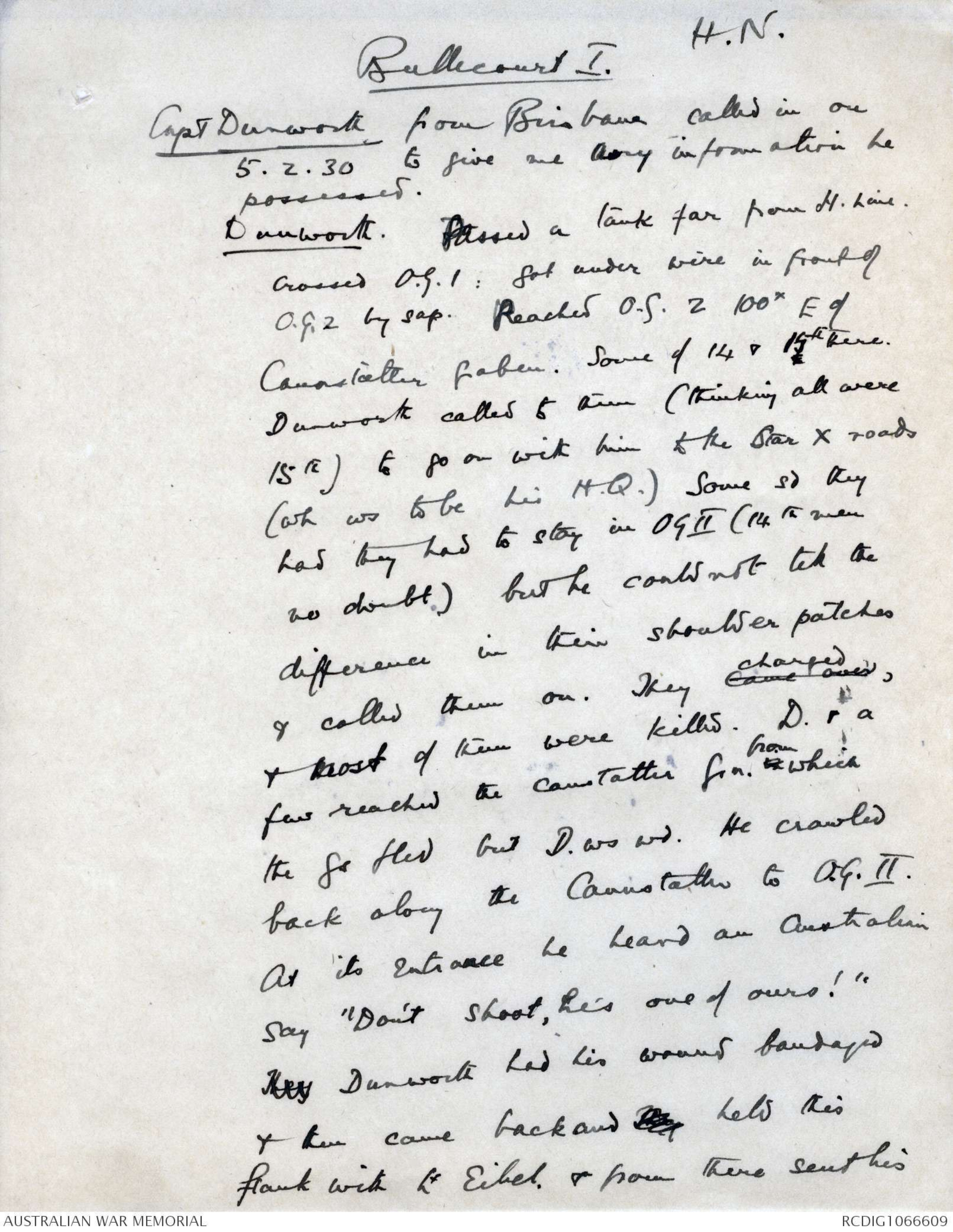
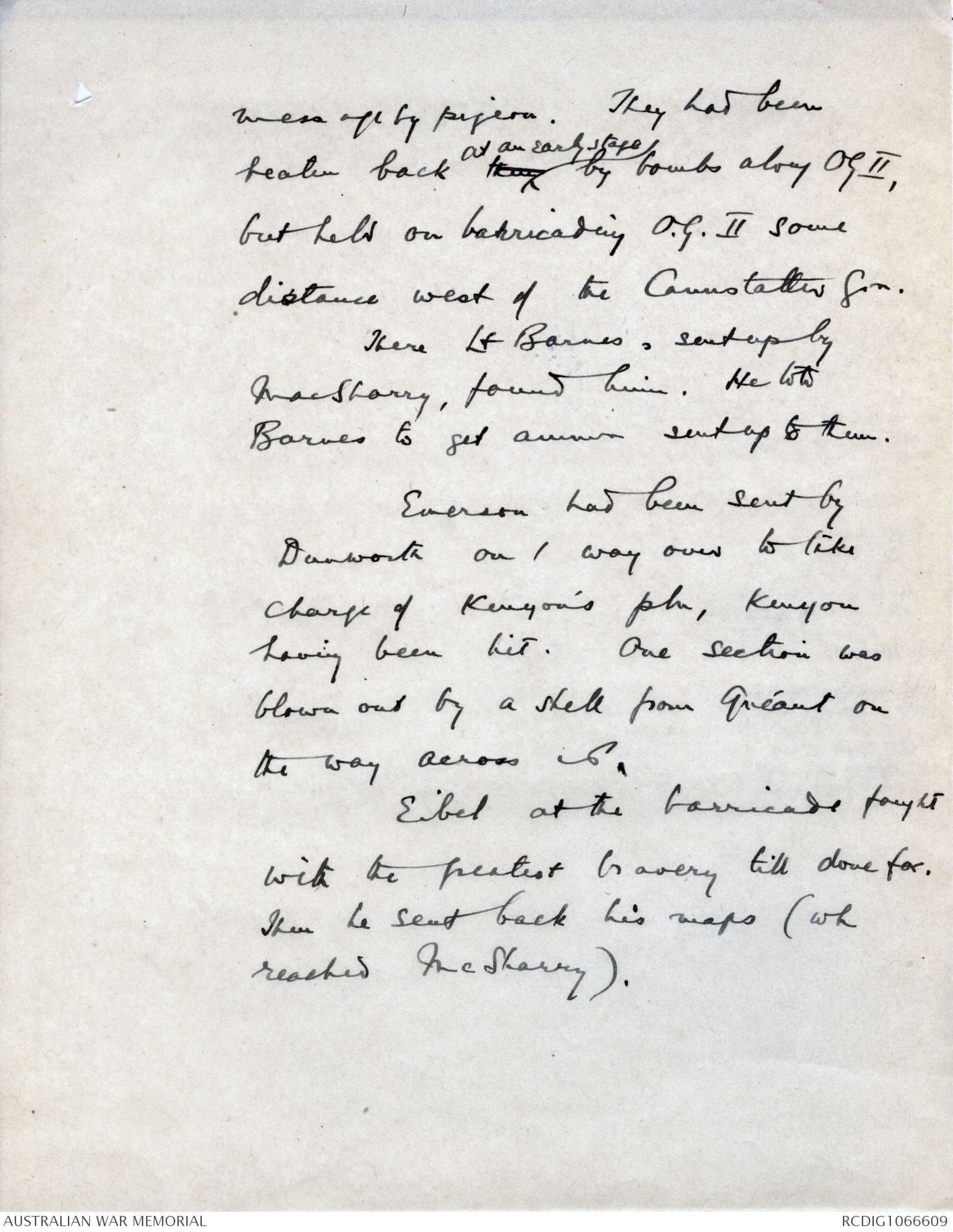
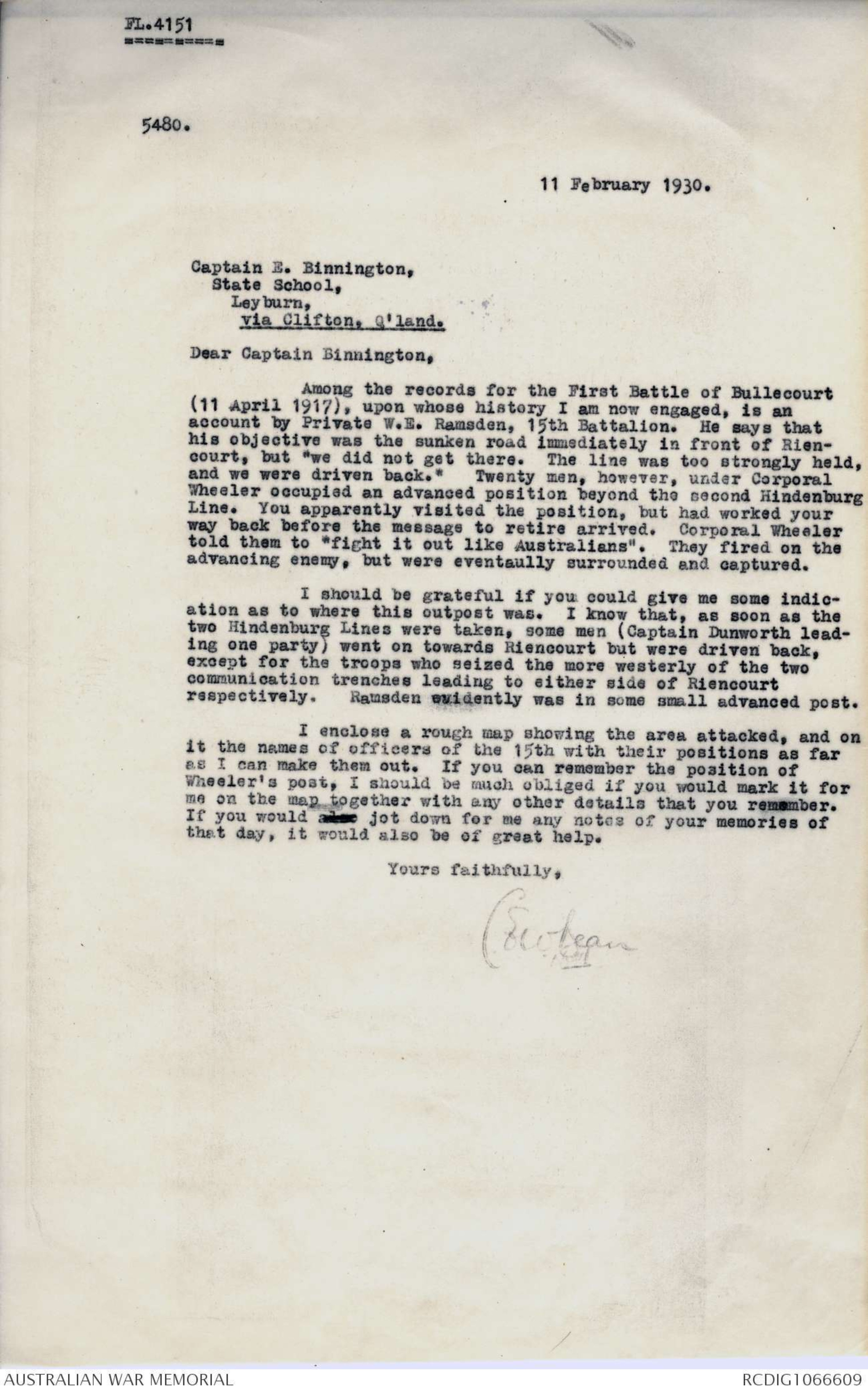

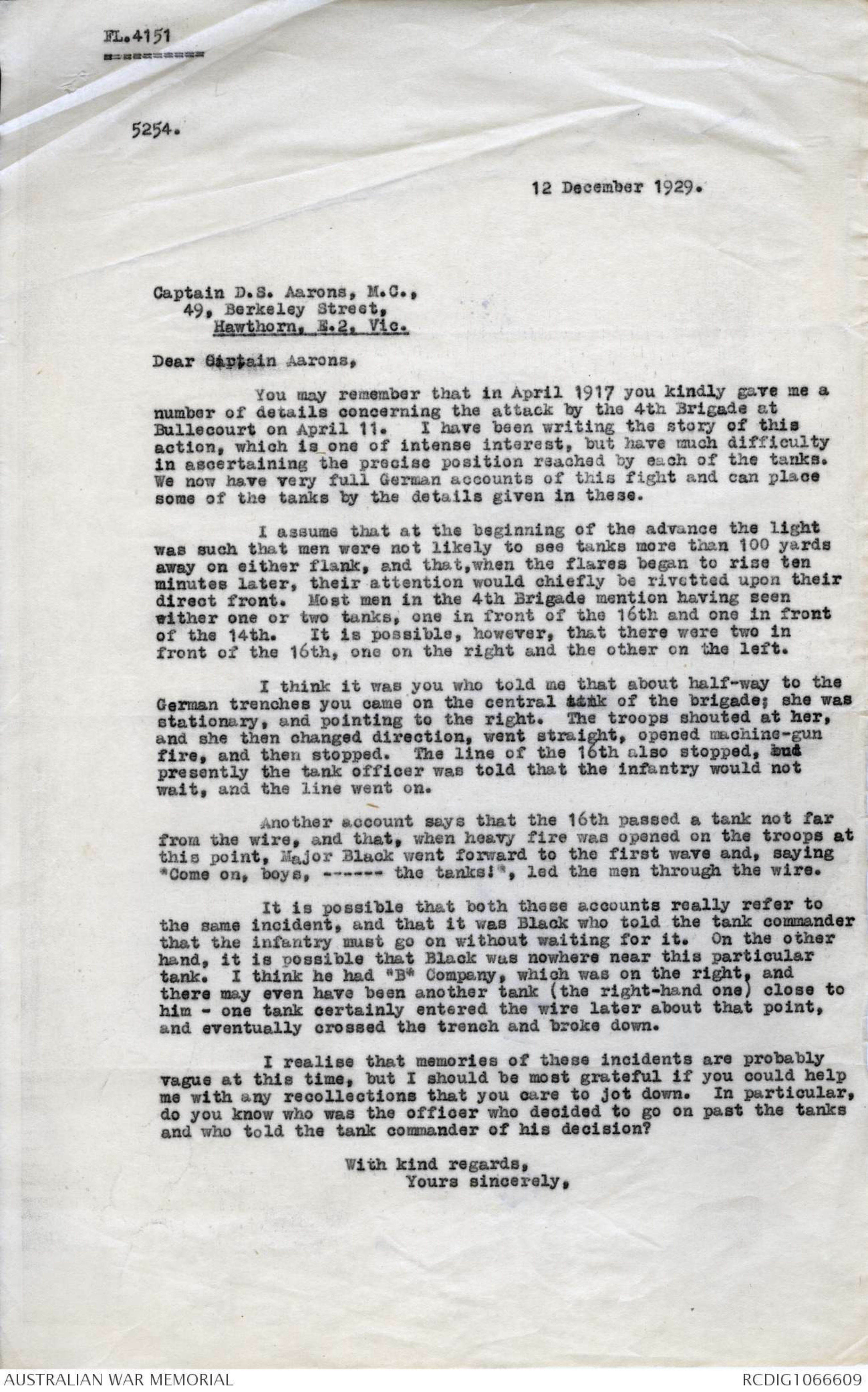
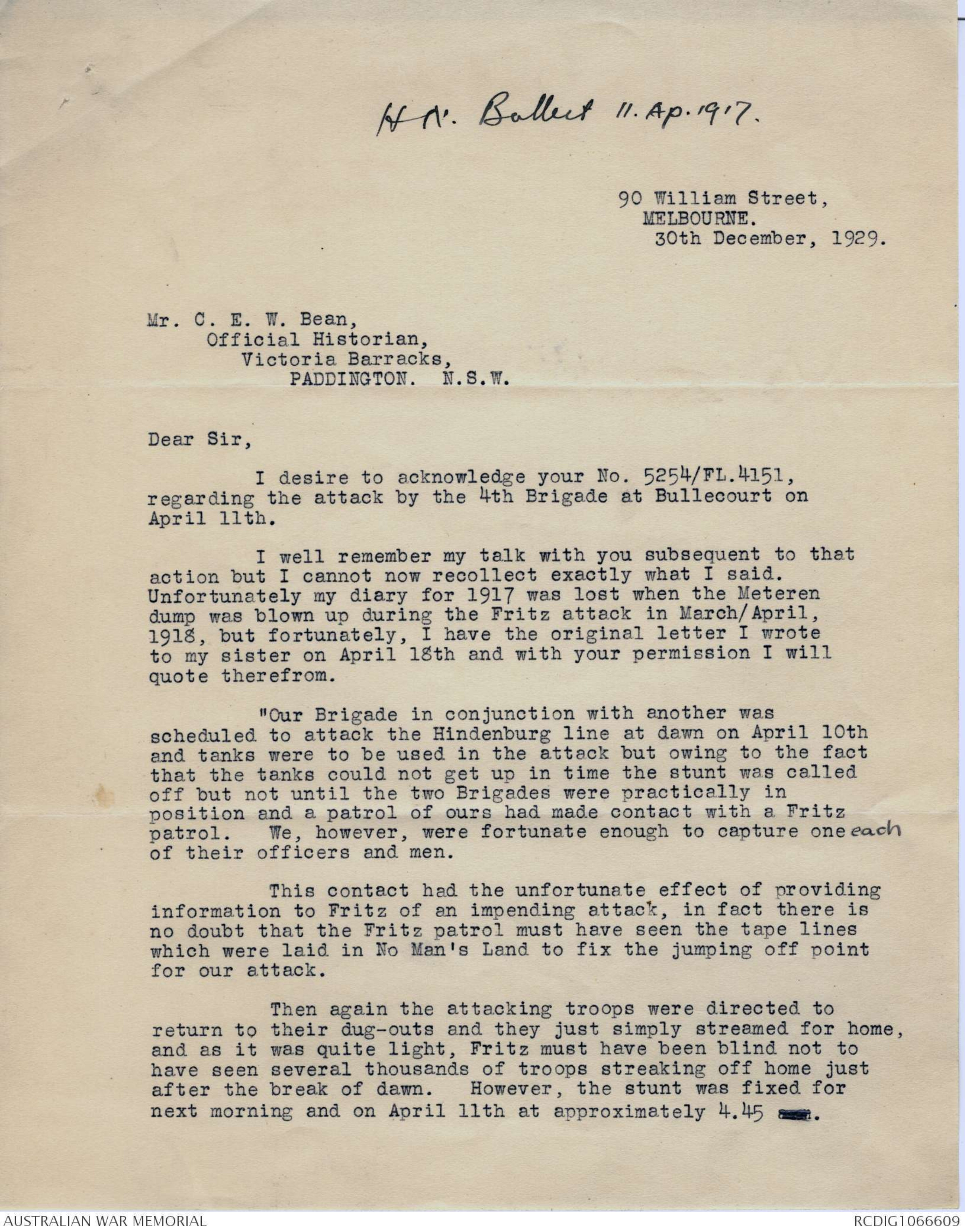
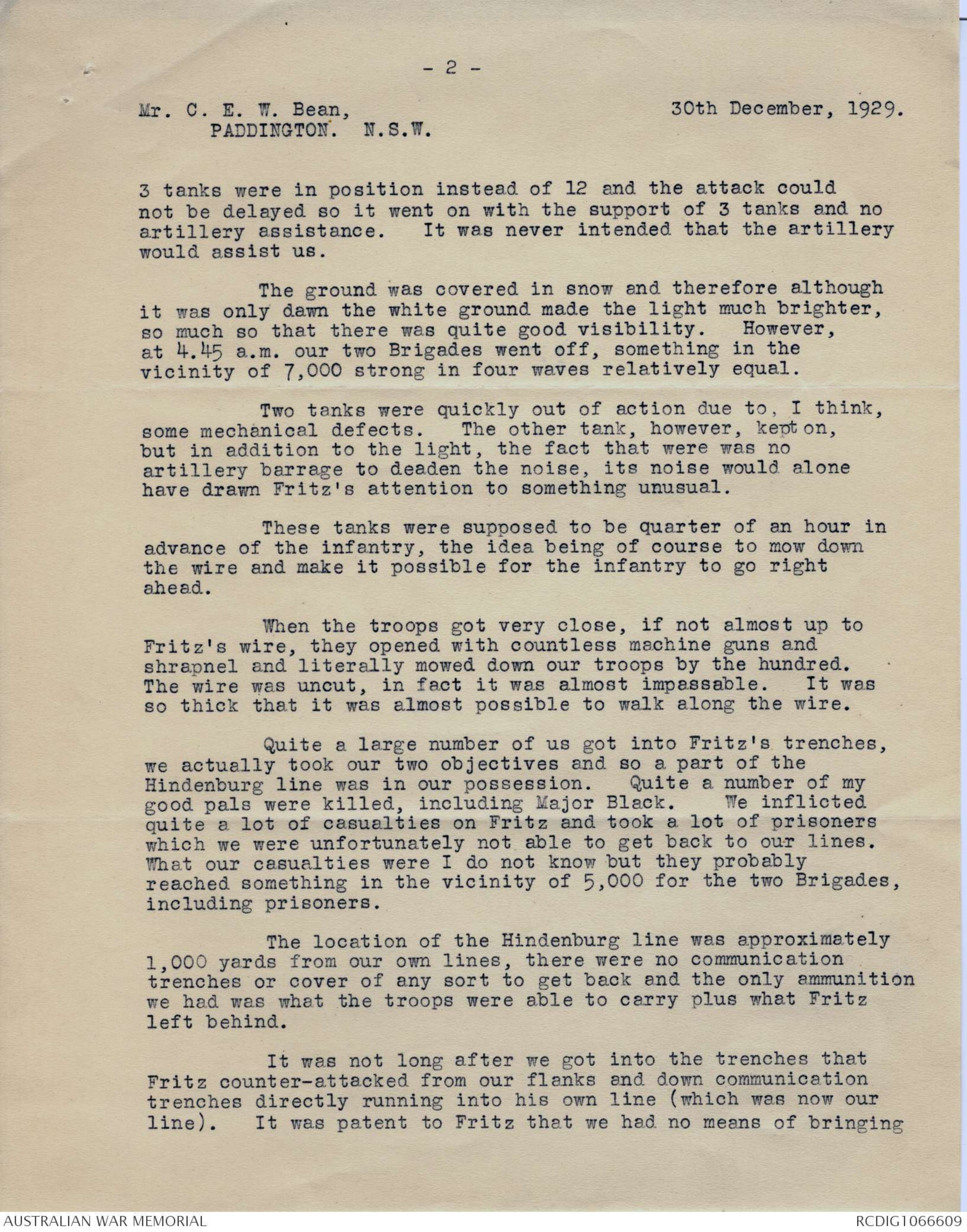
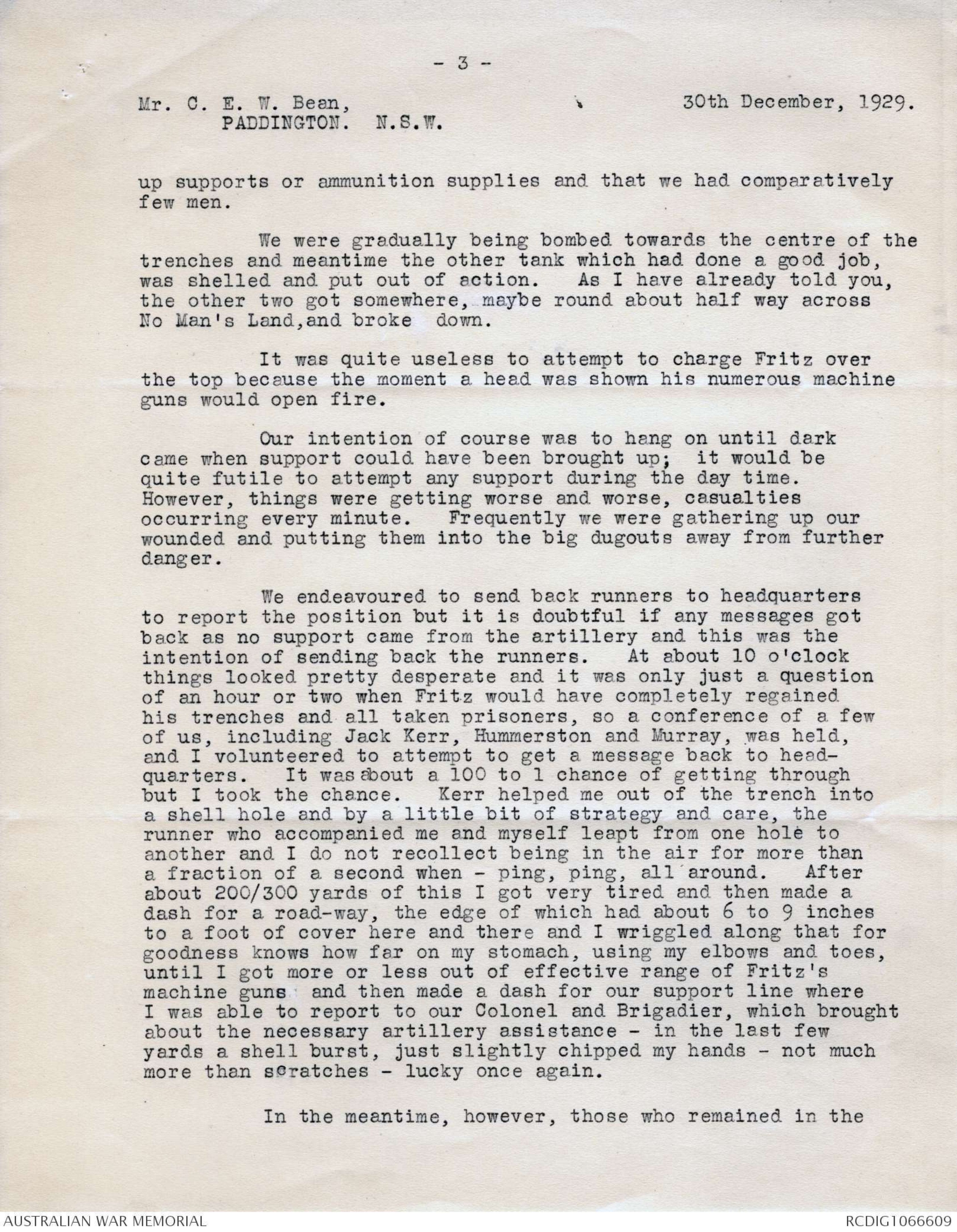

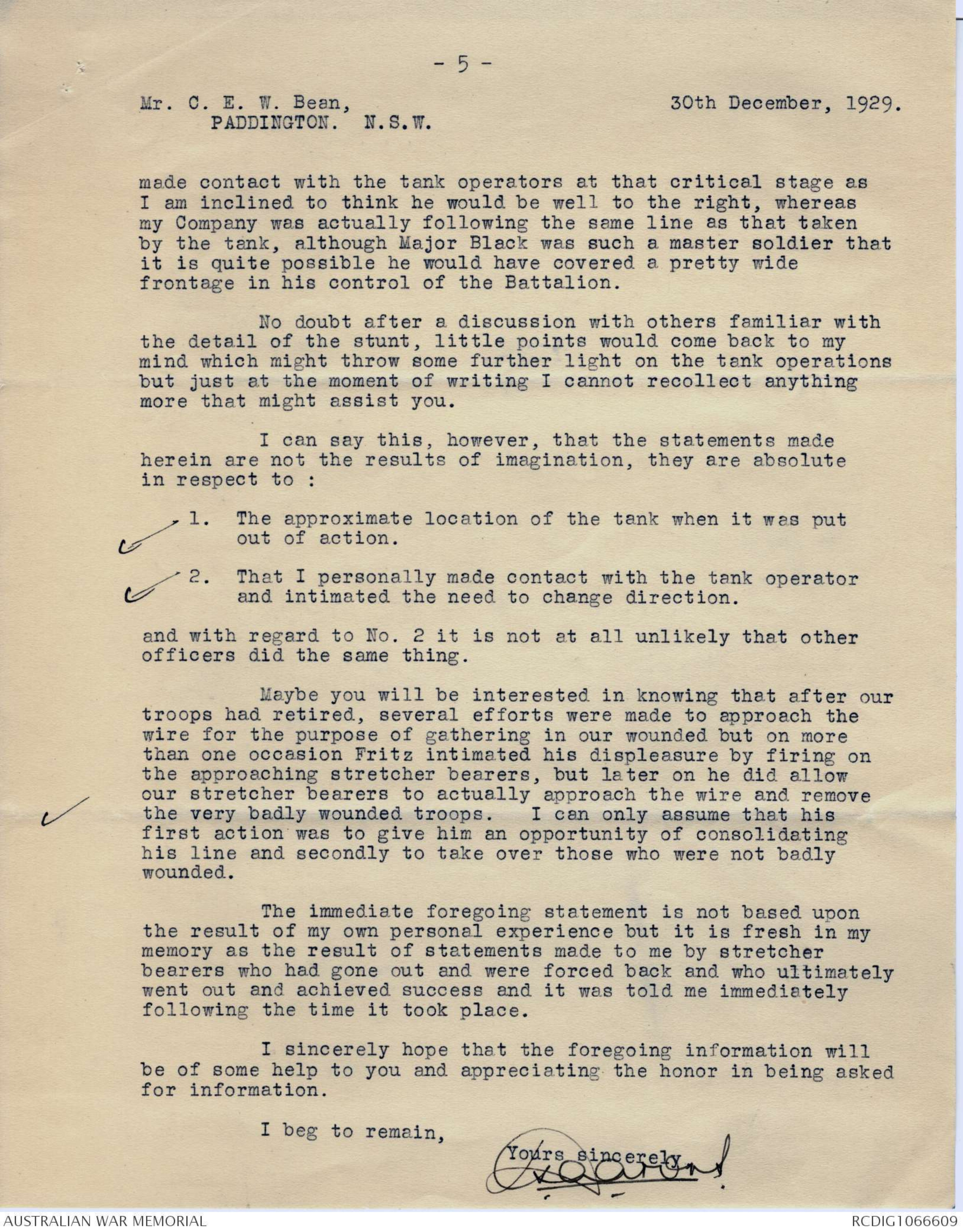
H.N.
BULLECOURT 1.
Capt Dunworth from Brisbane called in on
5.2.30 to give me the information he
possessed.
Dunworth passed a tank far from H. Line
crossed O.G.1: got under wire in front of
O.G.2 by sap. Reached O.G. 2 100th E of
Canstatter [[?]]. Some of 14 & 15th there.
Dunworth called to them (thinking all were
15th) to go with him to the Star X roads
wh ws to be his H.Q.). Some sd they
had they had to stay in O.G.11 (14th men
no doubt) but he could not tell the
difference in their shoulder patches
& called them on. They came over charged,
& most of them were killed. D. & a
few reached the Cannstatter frm, xx from which
the Gs fled but D. ws wd. He crawled
back along the Canstatter to O.G.II.
At its entrance he heard an Australian
say "Don't shoot, he's one of ours!"xxxx Dunworth had his wound bandaged
& then came back and xxxx held his
flank with Lt. Eibel & from there sent his
message by pigeon. They had been
beaten back ^at an early stage by bombs along OG II,
but held on barricading O.G. II some
distance west of Cannstatter farm.
There Lt. Barnes, sent up by
MacSharry, found him. He told
Barnes to get ammun sent up to them.
Emerson had been sent by
Dunworth on / way over to take
charge of Kenyon's pln, Kenyon
having been hit. One section was
blown out by a shell from Queant on
the way across nomansland.
Eibel at the barricade fought
with the greatest bravery till done for.
Then he sent back his maps (wh
reached McSharry).
FL.4151
5480.
11 February 1930.
Captain E. Binnington,
State School,
Leyburn,
via Clifton, Q'land.
Dear Captain Binnington,
Among the records for the First Battle of Bullecourt
(11 April 1917), upon whose history I am now engaged, is an
account by Private W.E. Ramsden 15th Battalion. He says that
his objective was the sunken road immediately in front of
Riencourt, but 'we did not get there. The line was too strongly held,
and we were driven back." Twenty men, however, under Corporal
Wheeler occupied an advanced position beyond the second Hindenburg
Line. You apparently visited the position, but had worked your
way back before the message to retire arrived. Corporal Wheeler
told them to "fight it out like Australians". They fired on the
advancing enemy, but were eventaully surrounded and captured.
I should be grateful if you could give me some indication
as to where this outpost was. I know that, as soon as the
two Hindenburg Lines were taken, some men (Captain Dunworth
leading one party) went on towards Riencourt but were driven back,
except for the troops who seized the more westerly of the two
communication trenches leading to either side of Riencourt
respectively. Ramsden evidently was in some small advanced post.
I enclose a rough map showing the area attacked, and on
it the names of officers of the 15th with their positions as far
as I can make them out. If you can remember the position of
Wheeler's post, I should be much obliged if you would mark it for
me on the map together with any other details that you remember.
If you would xxxx jot down for me any notes of your memories of
that day, it would also be of great help.
Yours faithfully,
C.E.W.Bean
FL.4151
5539.
22 February 1930.
W.E. Ramsden, Esq.,
Lewisham Boarding House,
Wharf Street,
Brisbane, Q'land.
Dear Sir,
Among the records of the First Battle of Bullecourt,
on the history of which I am at present at work, is a very
interesting narrative from yourself. I aam anxious to ascertain
the precise position of the advanced post which Corporal Wheeler
and your party were holding. Was it to the left or right of the
advanced communication trench to Riencourt, which was held by
the Australians? I should be most grateful if you could see
your way to jot down for me any recollections of the battle;
and I would send you a sketch-map on which the position of your
post could be marked.
Yours faithfully,
C.E.W. Bean
FL.4151
5254.
12 December 1929.
Captain D.S. Aarons, M.C..
49, Berkeley Street,
Hawthorn, E.2, Vic.
Dear Captain Aarons,
You may remember that in April 1917 you kindly gave me a
number of details concerning the attack by the 4th Brigade at
Bullecourt on April 11. have been writing the story of this
action, which is one of intense interest, but have much difficulty
in ascertaining the precise position reached by each of the tanks.
We now have very full German accounts of this fight and can place
some of the tanks by the details given in these.
I assume that at the beginning of the advance the light
was such that men were not likely to see tanks more than 100 yards
away on either flank, and that, when the flares began to rise ten
minutes later, their attention would chiefly be rivetted upon their
direct front. Most men in the 4th Brigade mention having seen
either one or two tanks, one in front of the 16th and one in front
of the 14th. It is possible, however, that there were two in
front of the 16th, one on the right and the other on the left.
I think it was you who told me that about half-way to the
German trenches you came on the central link of the brigade; she was
stationary, and pointing to the right. The troops shouted at her,
and she then changed direction, went straight, opened machine-gun
fire, and then stopped. The line of the 16th also stopped, but
presently the tank officer was told that the infantry would not
wait, and the line went on.
Another account says that the 16th passed a tank not far
from the wire, and that, when heavy fire was opened on the troops at
this point, Major Black went forward to the first wave and, saying
"Come on, boys,----------the tanks!", led the men through the wire.
It is possible that both these accounts really refer to
the same incident, and that it was Black who told the tank commander
that the infantry must go on without waiting for it. On the other
hand, it is possible that Black was nowhere near this particular
tank. I think he had "B'" Company, which was on the right, and
there may even have been another tank (the right-hand one) close to
him - one tank certainly entered the wire later about that point,
and eventually crossed the trench and broke down.
I realise that memories of these incidents are probably
vague at this time, but I should be most grateful if you could help
me with any recollections that you care to jot down. In particular
do you know who was the officer who decided to go on past the tanks
and who told the tank commander of his decision?
With kind regards,
Yours sincerely,
H.N. Bullect 11 Ap.1917
90 William Street,
MELBOURNE
3Oth December ,1929.
Mr. C. E. W. Bean,
Official Historian.
Victoria Barracks
PADDINGTON. N.S.W.
Dear Sir,
I desire to acknowledge your No. 5254/FL. 4151
regarding the attack by the 4th Brigade at Bullecourt on
April 11th.
I well remember my talk with you subsequent to that
action but I cannot now recollect exactly what I said.
Unfortunately my diary for 1917 was lost when the Meteren
dump was blown up during the Fritz attack in March/April
1918, but fortunately, I have the original letter I wrote
to my sister on April 18th and with your permission I will
quote therefrom.
"Our Brigade in conjunction with another was
scheduled to attack the Hindenburg line at dawn on April 10th
and tanks were to be used in the attack but owing to the fact
that the tanks could not get up in time the stunt was called
off but not until the two Brigades were practically in
position and a patrol of ours had made contact with a Fritz
patrol. We, however, were fortunate enough to capture one each
of their officers and men.
This contact had the unfortunate effect of providing
information to Fritz of an impending attack, in fact there is
no doubt that the Fritz patrol must have seen the tape lines
which were laid in No Man's Land to fix the jumping off point
for our attack.
Then again the attacking troops were directed to
return to their dug-outs and they just simply streamed for home
and as it was quite light, Fritz must have been blind not to
have seen several thousands of troops streaking off home just
after the break of dawn. However, the stunt was fixed for
next morning and on April 11th at approximately 4.45 xxxx.
- 2 -
3Oth December, 1929.
Mr. C. E. W. Bean,
PADDINGTON. N.S.W.
3 tanks were in position instead of 12 and the attack could
not be delayed so it went on with the support of 3 tanks and no
artillery assistance. It was never intended that the artillery
would assist us.
The ground was covered in snow and therefore although
it was only dawn the white ground made the light much brighter,
so much so that there was quite good visibility. However,
at 4.45 a.m. our two Brigades went off, something in the
vicinity of 7,000 strong in four waves relatively equal.
Two tanks were quickly out of action due to, I think
some mechanical defects. The other tank, however, kept on,
but in addition to the light, the fact that were was no
artillery barrage to deaden the noise, its noise would alone
have drawn Fritz's attention to something unusual.
These tanks were supposed to be quarter of an hour in
advance of the infantry, the idea being of course to mow down
the wire and make it possible for the infantry to go right
ahead.
When the troops got very close, if not almost up to
Fritz's wire, they opened with countless machine guns and
shrapnel and literally mowed down our troops by the hundred.
The wire was uncut, in fact it was almost impassable. It was
so thick that it was almost possible to walk along the wire.
Quite a large number of us got into Fritz's trenches,
we actually took our two objectives and so a part of the
Hindenburg line was in our possession. Quite a number of my
good pals were killed, including Major Black. We inflicted
quite a lot of casualties on Fritz and took a lot of prisoners
which we were unfortunately not able to get back to our lines.
What our casualties were I do not know but they probably
reached something in the vicinity of 5,000 for the two Brigades,
including prisoners.
The location of the Hindenburg line was approximately
1,000 yards from our own lines, there were no communication
trenches or cover of any sort to get back and the only ammunition
we had was what the troops were able to carry plus what Fritz
left behind.
It was not long after we got into the trenches that
Fritz counter-attacked from our flanks and down communication
trenches directly running into his own line (which was now our
line). It was patent to Fritz that we had no means of bringing
- 3 -
30th December, 1929.
Mr. C. E. W. Bean
PADDINGTON.
N.S.W.
up supports or ammunition supplies and that we had comparatively
few men.
We were gradually being bombed towards the centre of the
trenches and meantime the other tank which had done a good job,
was shelled and put out of action. As I have already told you,
the other two got somewhere, maybe round about half way across
No Man's Land,and broke, down.
It was quite useless to attempt to charge Fritz over
the top because the moment a head was shown his numerous machine
guns would open fire.
Our intention of course was to hang on until dark
came when support could have been brought up; it would be
quite futile to attempt any support during the day time.
However, things were getting worse and worse, casualties
occurring every minute. Frequently we were gathering up our
wounded and putting them into the big dugouts away from further
danger.
We endeavoured to send back runners to headquarters
to report the position but it is doubtful if any messages got
back as no support came from the artillery and this was the
intention of sending back the runners. At about 10 o'clock
things looked pretty desperate and it was only just a question
of an hour or two when Fritz would have completely regained
his trenches and all taken prisoners, so a conference of a few
of us, including Jack Kerr, Hummerston and Murray, was held,
and I volunteered to attempt to get a message back to
headquarters. It was about a 100 to 1 chance of getting through
but I took the chance. Kerr helped me out of the trench into
a shell hole and by a little bit of strategy and care, the
runner who accompanied me and myself leapt from one hole to
another and I do not recollect being in the air for more than
a fraction of a second when - ping, ping, all around. After
about 200/300 yards of this I got very tired and then made a
dash for a road-way, the edge of which had about 6 to 9 inches
to a foot of cover here and there and I wriggled along that for
goodness knows how far on my stomach, using my elbows and toes,
until I got more or less out of effective range of Fritz's
machine guns; and then made a dash for our support line where
I was able to report to our Colonel and Brigadier, which brought
about the necessary artillery assistance - in the last few
yards a shell burst, just slightly chipped my hands - not much
more than scratches - lucky once again.
In the meantime, however, those who remained in the
-4 -
3Oth December, 1929.
Mr. C. E. W. Bean,
PADDINGTON. N.S.W.
trenches had got together and decided to make a dash for
home and take the risk. Unfortunately it was necessary to
leave behind our wounded but some good chaps decided to forego
their chance of reaching safety by standing by the dugouts;
voluntarily offering themselves as prisoners in order that they
could prevent Fritz from bombing the dugout where our wounded
were located.
A little later on we were able to see our fellows
coming back individually and well scattered and in due course
many reached home."
The rest of the letter only deals with general details
of the stunt and does not help in any way with the questions
you ask.
Dealing now, however, with your letter in detail..
Regarding the point reached by the one tank .I am
not now absolutely sure but I can definitely and absolutely
picture it either lying across the wire or across a trench but
whether it was the actual front line trench or a sap leading
out through the wire I cannot now say, but I do know without
any question of doubt that it reached one or other of these
points.
The tank, during its approach to Fritz's line had
changed direction obliquely and it was I personally who ran up
to the tank and directed the operators to change direction.
The tank was firing at various times and it was its firing
across our line of approach that made it necessary for me to
communicate with the operators of the tank. I cannot now
recollect just how much firing took place from the tank after it
changed direction as once it changed direction I did not have
any further contact with the tank operators.
I am not in a position to make any comment upon the
fourth paragraph of yours under response, that is, with regard
to Major Black's appeal to the boys to go on without regard to
the tanks, although I do not doubt he would have made such a
statement, but even if he had not, the position was such that
the lads themselves would have gone forward. There was no
alternative.
Personally I cannot see that Major Black would have
5 -
Mr. C. E. W. Bean,
30th December, 1929.
PADDINGTON. N.S.W.
made contact with the tank operators at that critical stage as
I am inclined to think he would be well to the right, whereas
my Company was actually following the same line as that taken
by the tank, although Major Black was such a master soldier that
it is quite possible he would have covered a pretty wide
frontage in his control of the Battalion.
No doubt after a discussion with others familiar with
the detail of the stunt, little points would come back to my
mind which might throw some further light on the tank operations
but just at the moment of writing I cannot recollect anything
more that might assist you.
I can say this however, that the statements made
herein are not the results of imagination, they are absolute
in respect to :
√ 1. The approximate location of the tank when it was put
out of action.
√ 2. That I personally made contact with the tank operator
and intimated the need to change direction.
and with regard to No. 2 it is not at all unlikely that other
officers did the same thing.
Maybe you will be interested in knowing that after our
troops had retired, several efforts were made to approach the
wire for the purpose of gathering in our wounded but on more
than one occasion Fritz intimated his displeasure by firing on
the approaching stretcher bearers, but later on he did allow
our stretcher bearers to actually approach the wire and remove
the very badly wounded troops. I can only assume that his
first action was to give him an opportunity of consolidating
his line and secondly to take over those who were not badly
wounded.
The immediate foregoing statement is not based upon
the result of my own personal experience but it is fresh in my
memory as the result of statements made to me by stretcher
bearers who had gone out and were forced back and who ultimately
went out and achieved success and it was told me immediately
following the time it took place.
I sincerely hope that the foregoing information will
be of some help to you and appreciating the honor in being asked
for information.
I beg to remain,
Yours sincerely
D S Aarons
 Sam scott
Sam scottThis transcription item is now locked to you for editing. To release the lock either Save your changes or Cancel.
This lock will be automatically released after 60 minutes of inactivity.